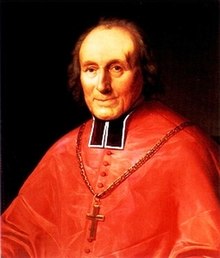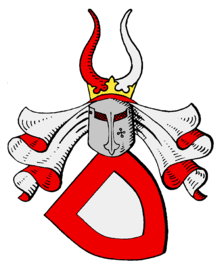Clemens August Droste zu Vischering

Clemens August Baron Droste zu Vischering , also known as Clemens August zu Droste-Vischering or Clemens August Droste zu Vischering (born January 22, 1773 in Münster , † October 19, 1845 in Münster), was from 1835 to 1845 as Clemens August II. Droste zu Vischering Archbishop of Cologne .
Life
Origin and family
Clemens August was the son of the married couple Clemens August Maria Droste zu Vischering (1742–1790) and Sophia Alexandrina Droste zu Füchten (1748–1817) of the noble family of barons Droste zu Vischering , one of the oldest and most important Westphalian families. He grew up with his five siblings. His older brother Adolf Heidenreich was Erbdroste and builder of the Erbdrostenhof , Kaspar Maximilian was Bishop of Münster, Franz Otto was a Catholic theologian and publicist and Maximilian Heidenreich was district administrator in Brilon
Career
Like his two brothers Kaspar Maximilian and Franz Otto, he prepared himself in Münster for a spiritual life. Through his brother Kaspar Maximilian, who had become auxiliary bishop in 1795 , he was ordained a priest on May 14, 1798 in Munster and became cathedral capitular . As such, on November 1, 1808, he founded the Congregation of the Sisters of Mercy of the Blessed Virgin and Sorrowful Mother Mary, based on the model of the Vincentian Sisters of Paul . The nuns, mostly referred to as Sisters of Clement after him , have dedicated themselves to nursing the sick.
On September 16, 1810, he became vicar general of the diocese of Münster . Right at the beginning of his church career, he strictly contradicted any compromise with the Prussian government on the controversial issue of bringing up children from interdenominational marriages . When this attitude brought him into open conflict with church officials who were looking for a compromise, Droste zu Vischering resigned from his position as vicar general in the summer of 1820 and devoted himself to charitable work in seclusion.
His brother Kaspar Maximilian, who had become bishop of Münster in 1825 , donated him episcopal ordination in 1827 after he had been appointed titular bishop of Calama . In the following years he worked as auxiliary bishop in the diocese of Münster. The Cologne Cathedral Chapter elected him on December 1, 1835 - primarily at the request of the Prussian Crown Prince and later King Friedrich Wilhelm IV. - as Archbishop of Cologne and successor to Ferdinand August von Spiegel . His enthronement followed on May 29, 1836.
In office, the new archbishop immediately began to follow a course close to ultramontanism , which was first shown in his energetic action against Hermesianism among the priests of his archdiocese. On September 17 and 18, 1837, the district president of Düsseldorf and the Prussian envoy at the papal court negotiated with him personally about the Berlin Convention of 1834, which his predecessor von Spiegel had concluded with Prussia as a compromise regulation on the question of mixed marriages; Clemens August refused to recognize the convention.
On the evening of November 20, 1837, the archbishop was arrested and placed under house arrest in Minden together with his secretary Eduard Michelis . He lived in rented quarters with constant surveillance in the house of the Catholic merchant Vogeler. Pope Gregory XVI protested loudly against the arrest of the archbishop. Droste zu Vischering became popular among German Catholics as the “confessor of confession”, which made him a crystallization figure of political Catholicism . The cathedral chapter under coadjutor Johannes von Geissel continued the business of the arrested man. On April 17, 1839, he was released from prison in Darfeld because of his poor health and then lived in seclusion in Münster. Negotiations between the curia and the archbishop with the Prussian state put an end to the Cologne church dispute in 1842.
His grave is in the high choir of St. Paulus Cathedral in Münster.
See also
literature
- Vote from Bavaria to the Berlin Protestants. Regensburg 1837 ( online ).
- Johann Friedrich Benzenberg : The Archbishop in Cologne. 1838. Digitized edition .
- Clemens August, the great confessor and martyr of our time: a word of consolation ... Kollmann, Augsburg 1838. Digitized edition of the University and State Library in Düsseldorf
- Bernhard Joseph Hilgers : Assessment of the facts through which the measures of the Prussian government against the Archbishop of Cologne, Clemens August, Baron Droste zu Vischering, were brought about: according to constitutional, canonical and purely theological principles. Osterrieth, Frankfurt am Main 1838. Digitized edition .
- Clemens A. Droste zu Vischering: About peace among the church and the states. Along with remarks on the well-known Berlin statement. Munster 1843.
- Anton Joseph Binterim : The Archbishop of Cologne Clemens August, Baron Droste zu Vischering writing on peace between the Church and the States: with a justification against the author of the persons and conditions from the political turmoil in Prussia and with several still unknown documents. Halenza, Mainz 1844. Digitized edition
- Clemens August, Baron von Droste zu Vischering, Archbishop of Cöln: together with an appendix: Interesting character traits and some previously unprinted poems by the deceased. Theurer, Xanten 1845. Digitized edition
- Markus Hänsel: Clemens August, Baron Droste zu Vischering, Archbishop of Cologne, 1773–1845. Verlag Haensel-Hohenhausen, Hohenhausen, 1991, ISBN 3893490035 ( online )
- Leonard Ennen : Droste zu Vischering, Clemens August Freiherr von . In: Allgemeine Deutsche Biographie (ADB). Volume 5, Duncker & Humblot, Leipzig 1877, pp. 420-431.
- Walter Lipgens: Droste zu Vischering, Clemens August Freiherr von. In: New German Biography (NDB). Volume 4, Duncker & Humblot, Berlin 1959, ISBN 3-428-00185-0 , p. 133 ( digitized version ).
- Carl Mirbt: Droste - Vischering, Clemens August, Freiherr von . In: Realencyklopadie for Protestant Theology and Church (RE). 3. Edition. Volume 5, Hinrichs, Leipzig 1898, pp. 23-38.
- Marianne Nordsiek: The "Martyr of Minden". Communications of the Mindener Geschichtsverein, year 45 (1973), pp. 107–126.
- Friedrich Wilhelm Bautz : DROSTE-VISCHERING, Clemens August. In: Biographisch-Bibliographisches Kirchenlexikon (BBKL). Volume 1, Bautz, Hamm 1975. 2nd, unchanged edition Hamm 1990, ISBN 3-88309-013-1 , Sp. 1391-1395.
Web links
- Entry on Klemens August Droste zu Vischering on catholic-hierarchy.org
- Literature by and about Clemens August Droste zu Vischering in the catalog of the German National Library
- Clemens August Droste zu Vischering in the Lexicon of Westphalian Authors
Individual evidence
- ↑ Baptism - KB001_2 | Munster, St. Servatii | Münster, rk. Diocese | Germany | Matricula Online. Retrieved June 12, 2020 .
- ↑ Deaths - KB008 | Münster, St. Paulus Dom | Münster, rk. Diocese | Germany | Matricula Online. Retrieved June 12, 2020 .
- ^ Website of the Sisters of Clement
| predecessor | Office | successor |
|---|---|---|
| Ferdinand August von Spiegel |
Archbishop of Cologne 1835–1845 |
Johannes von Geissel |
| personal data | |
|---|---|
| SURNAME | Droste zu Vischering, Clemens August |
| ALTERNATIVE NAMES | Droste zu Vischering, Clemens August Freiherr; Droste-Vischering, Clemens August zu; Droste zu Vischering, Klemens August |
| BRIEF DESCRIPTION | German clergyman, Archbishop of the Archdiocese of Cologne (1835–1845) |
| DATE OF BIRTH | January 22, 1773 |
| PLACE OF BIRTH | Muenster |
| DATE OF DEATH | October 19, 1845 |
| Place of death | Muenster |

